ISSN 2410-5708 / e-ISSN 2313-7215
Year 9 | No. 25 | p. 148 - 161 | June - September 2020
© Copyright (2020). National Autonomous University of Nicaragua, Managua.
This document is under a Creative Commons
Attribution-NonCommercial-NoDerivs 4.0 International licence.
Burnout syndrome in teachers of UNAN-Managua, FAREM-Carazo, in the second semester 2019
https://doi.org/10.5377/torreon.v9i25.9852
Submitted on January 28, 2020 / Accepted on March 23, 2020
U.G. Bismarck Santiago Mena Aburto
Psicology student
UNAN-Managua, FAREM-Carazo
U.G. Angelie Michelle Guevara García
Psicology student
UNAN-Managua, FAREM-Carazo
Keywords: stress, teachers, burnout syndrome, prevalence.
Abstract
Stress is the characterization of signs and symptoms that affect physical and psychological levels in people. It is common in the workplace, specifically in those where services or assistance are provided to third-parties, this is called “Burnout syndrome”.
The present study investigates this syndrome in the teachers who make up the academic departments of UNAN-Managua; FAREM-Carazo, during the second semester of 2019 some behaviors or comments from teachers towards students were considered as indicators of the manifestation of the syndrome of burnout syndrome, these qualify within the theory of Jackson & Maslach on the study problem therefore it was determined to evaluate the prevalence of this syndrome in order to indicate the relationship between the sociodemographic variables of sex and age as factors that require special attention, for this, a descriptive study was carried out, with a cross-section characteristic of quantitative studies.
The study includes a theoretical analysis related to the problem under study, likewise, a standardized instrument was used to measure the different dimensions where stress is manifested in an individual. This psychometric instrument allowed to collect statistical data that were processed in the corresponding statistical programs using descriptive statistics, these results were analyzed from the theoretical approaches addressed, allowing a discussion on the prevalence of burnout syndrome, concluding that there is a low presence of this syndrome in FAREM-Carazo teachers.
Introduction
The main objective of this article is to assess the burnout stress in teachers of UNAN Managua, FAREM Carazo, in the second semester of 2019, for this, the existing prevalence of burnout syndrome of teachers should be determined, in order to describe the levels of emotional exhaustion, depersonalization and personal fulfillment and indicate the prevalence of this syndrome according to sex and age. Stress is understood as the psychological and physiological responses to an event or situation that affects a person’s well-being, according to APA (2014). Stress is a “pattern of specific and non-specific responses that a person experiences before stimuli that disturb its balance and challenge or exceed its ability to cope with them “(p. 822).
Work stress is generated from the demands that exist in an organization and its environment, this has been the starting point of this study, since the approach to the subject in previous studies has been limited to evaluations of work performance in organizations that do not accurately describe burnout syndrome. The authors García R., et al (2009) define burnout syndrome as “a state of physical and psychological tension that occurs when there is an imbalance between the demands of the work organization, the labor environment, and the resources of the workers to face them” (p. 44).
Job burnout and occupations lead to the appearance of the exposed state in teachers, first of all it is necessary to assess, what is the prevalence of burnout syndrome to which teachers of the FAREM-Carazo are exposed, in the second semester 2019? In order to describe and contextualize new data in relation to this issue, likewise, by the implemented methodology, it will be possible to establish the prevalence of the burnout syndrome, allowing the development of new studies and the creation of new hypotheses related to the case, as well as provide an academic contribution based on the results obtained, analyzed and discussed.
Methods
Type of study
The study is an applied investigation, the quantitative approach was used, which allowed to determine, describe and indicate the burnout syndrome in teachers of UNAN-Managua, FAREM-Carazo; A non-experimental cross-sectional design with a descriptive scope was used.
Participants
The sample was made up of 99 teachers from UNAN-Managua, FAREM-Carazo, which was obtained through the STATS ™ 2.0 program. This sample is divided into three departments; 45 teachers from the Department of Education Sciences and Humanities, 28 teachers from the Department of Sciences, Technology and Health, 26 teachers from the Department of Economic and Administrative Sciences, this sample was selected using the formula for obtaining subgroups of samples:

Given the refusal of some teachers to participate in this study, despite the consent and authorization previously requested from each of the directors of the academic departments, and the labor subsidy in which some teachers were at the time of application, prevented that the instruments be applied in their entirety, for which only 73 instruments were applied (37 teachers from the Department of Education and Humanities Sciences, 19 teachers from the Department of Economic and Administrative Sciences and 17 teachers from the Department of Sciences, Technology and Health , the margin of error varied to 7% based on the formula for social studies, this margin of error is acceptable for studies of a social nature:

The study sampling is of a stratified probabilistic type, which consists of dividing the population into different subgroups or strata, these strata being the academic departments of FAREM-Carazo. The choice of this type of sampling was made with the intention of obtaining equitable results by evaluating more precise samples.
Instruments
The Maslach Burnout Inventory (MBI) was applied, which consists of three dimensions that are individually evaluated, which were processed in the Microsoft Excel version 2013 program to create a database used to enter obtained data in a second stage in the statistical program SPSS version 18 and Microsoft Excel 2013, in order to obtain the statistical results of the research.
Results
The definition of stress itself is adapted to the context, depending on the literature and theories, the designation of stress described in this study corresponds to that presented by people who have assistance jobs such as teaching, health and safety services.
Maslach & Jackson (1997), Postulate three dimensions of stress, these address the psychological, motivational and personal areas of the individual, when classifying them they give a guideline to determine the levels of stress that exist in the person.
Substantially it should be clarified that the MBI and its evaluation dimensions do not measure levels of stress present in a population, but rather, it seeks to indicate the prevalence by correlating its dimensions.
Graph 1 represents the burnout syndrome present in the FAREM-Carazo teachers, this result was obtained in the individual correction of the dimensions of burnout syndrome where two of those evaluated, corresponding to 2.7%, achieved scores that indicate the presence of burnout syndrome, while 97.3% reflect that teachers do not have it or indicate the presence of this, but rather external factors that generate other types of stress that are not linked to the field of teaching.
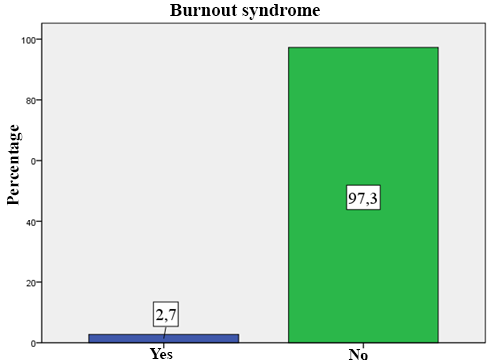
Graph 1. Burnout syndrome
Graph 2 depicts the dimension of emotional exhaustion, resulting in 8.2% having emotional fatigue, while 24.7% has medium fatigue, and the remaining 67.1% projects low fatigue.
By obtaining a high score in this dimension, it means that the person it is found in situations in which he or she feels emotionally exhausted caused by his work environment.
These situations could provoke repercussions on the individual’s state of mind, such as feelings of apathy, melancholy and uselessness and have derivations in the social and behavioral area, however, globally in this dimension, the indicator of low emotional fatigue predominates, exposing that the subjects evaluated with low scores show feelings of satisfaction and satisfaction in their work environment.
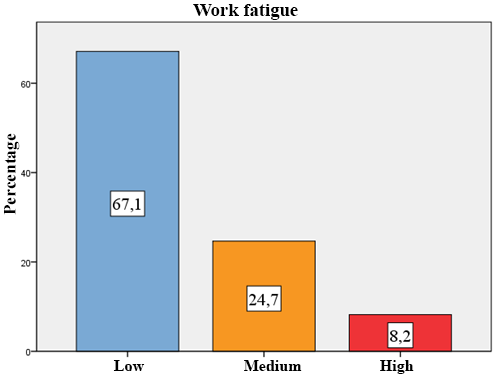
Graph 2. Work fatigue
Graph 3 corresponds to the dimension Depersonalization in which the sample evaluated resulted in 13.7% of teachers having low depersonalization, while 38.4% shows medium depersonalization and the remaining 47.9% projected high depersonalization.
The dimension of Depersonalization is understood as the responses that the individual evaluated manifests on the elements or situations that he or she experiences in his or her work environment, if the score is high in this dimension, it exposes that the individual expresses cold responses or acts as an external observer before day-to-day eventualities based on his or her functions directed to the receivers or to the positions held by the professional.
In this dimension, the high score predominates, which refers to the fact that the teachers evaluated act in certain situations depending on their personality with apathy, negativity and cynicism, while others try to at least deal with those situations offering answers that they do not like or with a neutral attitude.
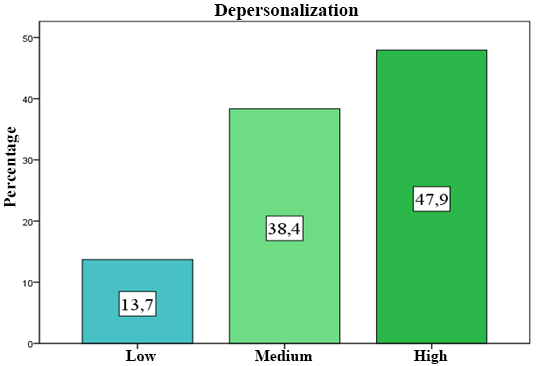
Graph 3. Depersonalization
Graph 4 represents the personal achievement of the evaluated teachers, the results obtained show that 67.1% of the sample has a low personal achievement, 24.7% of the evaluated sample has an average Personal Achievement and 8.2% of the sample presents a high performance with respect to the position it performs.
In the Personal Achievement dimension, a low score shows that the professional has a low performance perspective or little competence in the development of its work, expressing feelings of exhaustion, displeasure, disappointment or low self-esteem, that their expectations have been displaced and its functions are not enhanced by competence, but as an obligation of its work.
Only 8.2% of those evaluated scored a high personal achievement, which is equivalent to having a high self-esteem, feeling comfortable in the position in which they are in their workplace and in the performance of their work contrary to 61.7% who refer that their work is a burden that has not supported their personal and academic needs.
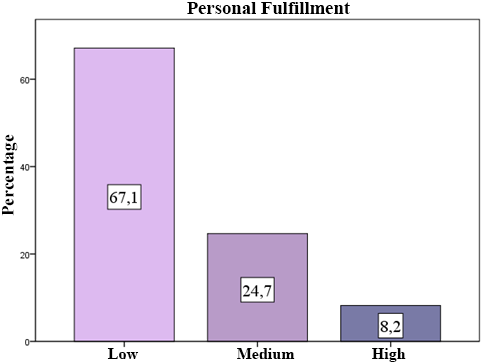
Graph 4. Personal Fulfillment
Graph 5 shows the prevalence of burnout syndrome in teachers according to sex, it is observed that 3% of the sample belonging to the female sex and 3% that belongs to the male sex, suffer from burnout syndrome, contrary to this, 97% of the sample of both sexes, does not present this condition.
This result indicates that the prevalence of sex and burnout syndrome that affects male and female teachers equally, when evaluating the sample there is a trend that burnout syndrome affects men and women in this sector equally of this institution.
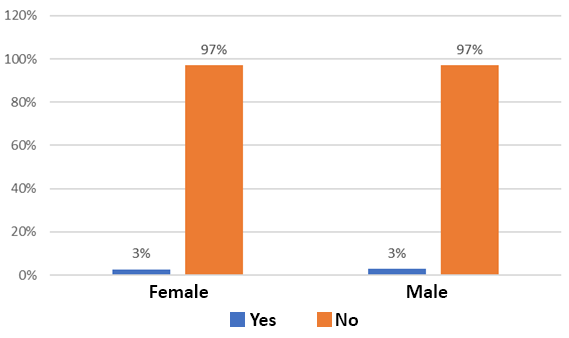
Graph 5. Prevalence of burnout syndrome in teachers according to sex
Figure 6 shows the prevalence of burnout syndrome according to age of the sample evaluated, in which it is observed that 100% of those evaluated, aged between 29-39 years, do not suffer from this condition.
The 94.45% that comprise the ages between 40-59 years, do not present this circumstance, but in this same age range there are 5.55% that do present this state, it should be noted that 100% of those evaluated do not indicate their age , neither do they state that they suffer from burnout syndrome.
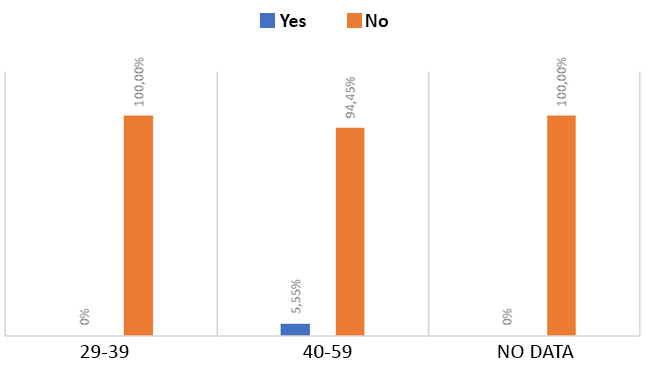
Graph 6. Prevalence of burnout syndrome according to age
Discussion
Stress is one of responses that the body hurries to an unpleasant or expected stimulus, these responses could lead to reactions at the cognitive, affective or behavioral level in broad strokes depending on how the person is prepared to assume such situations. The APA (2013) defines stress as a “pattern of specific and nonspecific responses that a person experiences when faced with stimuli that disturb their balance and challenge or exceed its ability to cope with them” p. 822. This definition also links stress to disturbances that can interfere with a person’s well-being and balance, significantly affecting the person’s daily life.
According to the approaches of the references of this study, it expresses that the main manifestations that a person suffering from stress could have are at the cognitive, affective and behavioral level, which are manifested in multiple ways such as in the reactions that the person might have to situations; As a result of an episode of stress such as aggressiveness, resignation, thoughts of uselessness or dissatisfaction, it could overwhelm a person’s mind along with feelings of anger, sadness and apathy, affecting their relationship with their social, work and family environment (Betancur, 2016).
Through the application of the Burnout Maslach Inventory (MBI), an instrument that indicates the prevalence of the syndrome under study, it was found that the presence of burnout syndrome is low in the teaching staff, because only 2 teachers are in line with the three dimensions required to confirm the presence of the syndrome, so the approach made in hypothesis 1 is ruled out, where it was indicated that the prevalence of burnout syndrome in FAREM-Carazo teachers is greater than 50%, the result obtained is under this approach.
The teachers that make up this higher education center are a group susceptible to stress due to the work environment in which they operate, as university teachers they are always in constant interaction with third parties (students) who have different ways of thinking and behave with different age ranges and psychosocial conditions that could interfere with relationships and the environment within the classroom.
The Burnout Maslach Inventory (MBI) is made up of three dimensions in which they complement each other to determine if the person in the sample evaluated presents stress.
In the first dimension, which corresponds to emotional exhaustion, it resulted in a low level, ruling out hypothesis 2 of this study, as the result was contrary to the approach made.
Teachers with this low level of emotional exhaustion, present mostly feelings of pleasure and satisfaction, naturally some of the teachers have a medium degree of exhaustion, while some isolated cases have a high level of emotional fatigue, which shows who are emotionally drained, and may manifest apathy, melancholy, or worthlessness.
As for Depersonalization, it resulted in a majority of teachers presenting a high level, which means that in the workplace their actions are apathy, cynicism, tend to give cold responses and are seen as an external agent in their academic environment. Statistical evaluations confirm that although teachers do not suffer from burnout syndrome, they can react to the stimuli of the work environment with responses or actions that are considered anomalous and unacceptable for coexistence, evidence of this was the treatment of a large part of teachers towards the evaluators, some were inaccessible while others discriminated negatively with comments or facial gestures of displeasure, confirming the theoretical approaches of Maslach and Jackson and the one made in hypothesis 3 of this study.
The last dimension that the test has is Personal Realization, it includes how the teacher feels in his or her position at work, the obtained result indicates a low level of achievement, which confirms the approach of the 4 hypothesis, it shows that they have the perception of underperforming and having degrees of disappointment, exhaustion or displeasure with respect to his or her position and work.
The previous result complements the data on high levels of depersonalization, however, the instrument requires that emotional exhaustion and depersonalization to be consistent to indicate that there is a prevalence of burnout syndrome. In this research, the consonance disagrees, the level of personal fulfillment and the levels of emotional exhaustion are similar, indicating that in parallel, those who make the least effort will have less personal fulfillment.
These results cannot be contrasted with the studies of reference to this because errors in the correction of this instrument have been found in previous investigations because the evaluators are unaware of the parametric procedures of a parametric type psychological instrument, however, Maslach and Jackson’s theory approach confirms and theoretically supports the results of the phenomenon in question.
The prevalence of care work stress in relation to gender indicates that there is 1 case for each gender, that is, the prevalence between men and women of burnout syndrome will be 1% for male and female teachers, ruling out the hypothesis 5, because according to this study, stress affects men and women equally, likewise, the relationship of burnout syndrome and age shows The older the person is, the more exposed to stress they will be, confirming what has been stated by Betancurt in his 2016 study that states that all subjects are exposed to stress regardless of sex and age.
The present results do not differ from an academic reality where teachers exercise their functions as an obligation and not a vocation, the levels of personal achievement are considerably low since some teachers indicate that they have not achieved their personal goals and objectives in relation to their job.
In characterizing an organizational performance evaluation process, the institution’s goals and objectives can be met, but the staff is not responding to their expectations, it is where frustration, apathy and depersonalized or minimized treatment of third parties provoke the need to get rid of tasks that are stressful to them and that have no direct relation to the teaching functions.
In general terms, the type of stress that is manifesting in this institution is stress called “Eustrés”, a positive type of stress that occurs when actions are taken in search of the fulfillment of organizational objectives, which do have to do with academic work, but it must be considered that the fulfillment of the objectives set by the institution is leading a large part of teachers to not meet their personal goals and that is where two of the teachers evaluated have already presented indicators of suffering burnout syndrome.
Conclusions
• The prevalence of burnout syndrome for teachers at UNAN-Managua; FAREM Carazo is low, but the results of the dimensions indicate that there are conditions that could contribute to the appearance of stress, although it does not correspond precisely to the syndrome under study.
• According to the data obtained, the level of emotional exhaustion is predominantly low, that is, teachers have low emotional exhaustion with respect to the exercise of their duties and that they achieve a certain degree of emotional compensation.
• It is established that the depersonalization in FAREM Carazo teachers is high, they show apathy, impersonal responses, coldness, disinterested responses, the result was evident during the data collection process, since the attitude that some of the evaluated were challenging, negative and uninterested.
• According to the results obtained, the level of personal achievement is low, the problem found suggests that teachers do not feel satisfied with their professional practice since their job expectations do not meet their personal expectations, although they are fully performing their professional functions, they are not meeting their personal expectations.
• It is indicated that the relationship between burnout syndrome in FAREM Carazo teachers and sex is not significant, the established theory that the study stress affects mostly women, cannot be affirmed, according to the results obtained in this study it appears in both genders.
• It is indicated that the presence of burnout syndrome in FAREM-Carazo teachers is more evident in older subjects, that is, the older they are, the greater the probability of suffering burnout syndrome.
References
Aamodt, M. G. (2010). Psicología industrial/organizacional 6a. edición. México D.F: Cengage Learning.
Asociación Americana de Psiquiatría, Manual diagnóstico y estadístico de los trastornos mentales (DSM-5®), 5a Ed. Arlington, VA, Asociación Americana de Psiquiatría, 2014.
APA. (2010). Centro de apoyo de la A.P.A. Disponible el 11 de septiembre de 2019, del Centro de Apoyo de la Asociación de Psicología Americana. Obtained from https://www.apa.org/centrodeapoyo/tipos
Barraza Macías, A., & Jaik Dipp, A. (2011). Estrés, burnout y bienestar subjetivo, Investigaciones sobre la salud mental de los agentes educativos. Durango: Instituto Universitario Anglo Español.
Betancur, M. (2016). El estrés laboral en los empleados de la Facultad De Ciencias Agrarias De La Universidad De Antioquia. Medición y mecanismos de afrontamiento. Obtained from Repositorio digital FCSH: http://200.24.17.74:8080/jspui/handle/fcsh/523
Chiavetano, I. (2009). Comportamiento organizacional, La dinámica del éxito en las organizaciones; Segunda edición. México D.F.: McGraw-Hill/Interamericana Editores, S.A. de C.V.
El-Sahili, L. (2010). Psicología para el Docente. Consideraciones sobre los riesgos y desafíos de la práctica magisterial. Guadajara, México.: Universidad de Guanajuato.
García, J., Gelp, J., Cano, A., & Catalina, C. (2009). Manual Ibermutuamur. Cómo combatir el estrés laboral. Madrid: Editorial y Producción Arteanima, S.L.
Gonzales, L. F. (2010). Psicología para el Docente: Consideraciones sobre los riesgos y desafíos de la práctica magisterial. Guadajara: Universidad de Guanajuato.
Herranz, J., Reig-Ferrer, A., & Cabrero, J. (2006). La prevalencia del estrés laboral asistencial entre los profesores universitarios. Obtained from RUA. Repositorio Institucional de la Universidad de Alicante: http://hdl.handle.net/10045/25008
Lazarus, R. (2000). Estrés y emoción manejo e implicaciones en nuestra salud. Madrid, España.: Editorial Desclée De Brouwer.
Marulanda Ruiz, I. C. (2009). Estrés laboral enemigo silencioso de la salud mental y la satisfacción con la vida, segunda edición. Bogotá, Colombia: Ediciones Uniandes.
Maslach, C., & Jackson, S. (1997). Inventario Burnout de Maslach. Madrid, España.: TEA Ediciones.
Pérez, P. (2015). Descripción estado de Burnout, antes y después de un programa de entrenamiento psicológico, mediante la escala MBI, en un grupo de docentes del colegio Gimnasio Pilares del Saber del municipio de Turbo. Obtained from Repositorio digital FCSH: http://200.24.17.74:8080/jspui/handle/fcsh/337
Sampieri, R. (2014). Metodología de la Investigación Sexta Edición. México D.F., México.: McGraw-Hill Education.
Sarason, I., & Sarason, B. (2006). Psicopatología, Psicología anormal. El problema de la conducta inadaptada. México D.F., México.: Pearson Education.
Torres, X., & Bailles, E. (2015). Comprender el estrés. Barcelona, España: Amat Editorial.